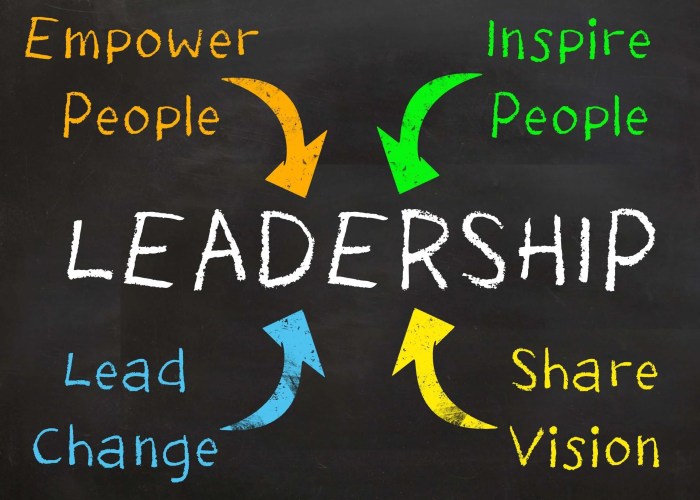Leadership Development is the key to unlocking the potential of individuals and organizations alike. Dive into this dynamic realm filled with strategies, tools, and insights that shape the leaders of tomorrow.
Importance of Leadership Development

Leadership development is crucial in organizations as it helps in cultivating strong leaders who can guide and inspire their teams towards success. Effective leadership can drive innovation, improve decision-making, and create a positive work culture.
Examples of Successful Companies
- Google: Known for its leadership development programs, Google invests heavily in training and developing its leaders to ensure a strong leadership pipeline.
- Apple: Apple focuses on developing leadership skills at all levels of the organization, which has contributed to its success and innovation.
- Amazon: Amazon’s leadership principles are well-known and play a key role in developing leaders who can drive the company’s growth and customer-centric approach.
Impact on Employee Engagement and Retention, Leadership Development
Effective leadership development can significantly impact employee engagement and retention. When employees have strong leaders who support their growth and development, they are more likely to be engaged and committed to their work. This, in turn, leads to higher retention rates and a more productive workforce.
Key Components of Leadership Development Programs

Leadership development programs are crucial for nurturing the next generation of leaders and ensuring the long-term success of organizations. These programs are designed to identify and cultivate key skills and traits that are essential for effective leadership in various contexts.
Role of Mentorship and Coaching
Mentorship and coaching play a pivotal role in leadership development programs. Mentors provide guidance, support, and valuable insights based on their own experiences, helping aspiring leaders navigate challenges and develop their potential. Coaches, on the other hand, offer personalized feedback, help individuals set goals, and provide strategies for growth and improvement. Both mentorship and coaching contribute to the holistic development of leaders, enhancing their self-awareness, decision-making skills, and emotional intelligence.
Comparison of Leadership Development Models
There are various models of leadership development, each with its own strengths and weaknesses. Some programs focus on experiential learning, where leaders are exposed to real-world challenges and opportunities to apply their skills. Others emphasize formal training and education, providing theoretical knowledge and practical tools for effective leadership. Hybrid models combine different approaches to create a comprehensive learning experience. The effectiveness of a leadership development model depends on factors such as organizational culture, leadership goals, and individual learning styles. It is essential to align the chosen model with the specific needs and objectives of the organization to maximize its impact.
Strategies for Implementing Leadership Development
Implementing a successful leadership development program requires careful planning and execution. Below are key strategies to consider when designing and implementing such initiatives:
Designing a Leadership Development Program
- Identify organizational goals: Align the leadership development program with the overall goals and values of the organization to ensure relevance and effectiveness.
- Assess current leadership skills: Conduct a thorough assessment of current leadership capabilities to determine areas for improvement and development.
- Develop a customized curriculum: Tailor the leadership development program to address specific skill gaps and developmental needs of participants.
- Utilize a variety of learning methods: Incorporate a mix of training methods such as workshops, mentoring, coaching, and on-the-job experiences to enhance learning and skill acquisition.
Evaluating the Success of Leadership Development Initiatives
- Establish clear metrics: Define key performance indicators (KPIs) to measure the impact of the leadership development program on individuals and the organization.
- Gather feedback: Collect feedback from participants, supervisors, and stakeholders to assess the effectiveness of the program and identify areas for improvement.
- Track progress: Monitor the progress of participants throughout the program to ensure they are meeting learning objectives and developing essential leadership skills.
- Measure ROI: Evaluate the return on investment (ROI) of the leadership development program by comparing the costs incurred with the benefits gained in terms of improved leadership capabilities and organizational performance.
Challenges in Implementing Leadership Development Strategies
- Resistance to change: Some employees may resist participating in leadership development initiatives due to fear of change or lack of motivation.
- Lack of resources: Limited budget, time, or expertise can hinder the successful implementation of a leadership development program.
- Alignment with organizational culture: Ensuring that the leadership development program aligns with the existing organizational culture and values can be a challenge.
- Sustainability: Maintaining long-term engagement and commitment to leadership development may be difficult without ongoing support and reinforcement.
Technologies and Tools for Leadership Development
In today’s fast-paced digital world, technology plays a crucial role in modern leadership development programs. By leveraging innovative tools and e-learning platforms, organizations can enhance leadership assessment and training, leading to more effective and efficient leadership development.
Role of Technology in Leadership Development
Technology enables leaders to access training materials anytime, anywhere, allowing for flexibility and convenience in their development journey. Virtual simulations and online assessments provide valuable insights into a leader’s strengths and areas for improvement, helping them grow and excel in their roles.
Innovative Tools for Leadership Assessment and Training
– Virtual Reality (VR) simulations offer immersive experiences for leaders to practice decision-making in realistic scenarios.
– Artificial Intelligence (AI) powered tools analyze leadership behaviors and provide personalized feedback for continuous improvement.
– Mobile applications provide on-the-go access to leadership resources, such as videos, podcasts, and articles, enhancing learning opportunities.
Benefits of E-Learning Platforms in Leadership Development
- E-Learning platforms offer self-paced learning, allowing leaders to progress at their own speed.
- Interactive modules and quizzes engage learners and reinforce key concepts for better retention.
- Cost-effective solutions reduce the need for in-person training sessions, saving time and resources for organizations.





